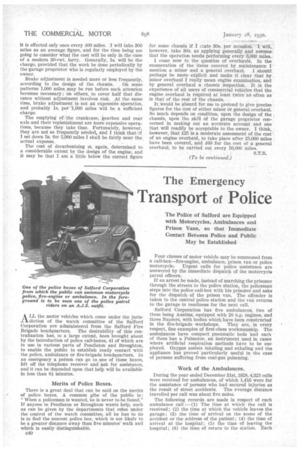The Emergency
Page 62

Page 63

If you've noticed an error in this article please click here to report it so we can fix it.
Transport of Police The Police of Salford are Equipped with Motorcycles, Ambulances and Prison Vans, so that Immediate Contact Between Police and Public May be Established A LI, the motor vehicles which come under the juris.1-11-diction of the watch committee of the Salford Corporation are administered from the Salford Fire Brigade headquarters. The desirability of this centralization has, to a large extent, been brought about by the introduction of police call-boxes, 41 of which are in use in various parts of Pendleton and Broughton, to enable the public to establish ready contact with the police, ambulance or fire-brigade headquarters. In an emergency a person can go to one of these boxes, lift off the telephone receiver and ask for assistance, and it can be depended upon that help will be available in less than 6i minutes.
Merits of Police Boxes.
There is a great deal that can be said on the merits of police boxes. A common gibe of the public is: " When a policeman is wanted, he is never to be found." If anyone in Pendleton or Broughton wants help, such as can be given by the departments that come under the control of the watch committee, all he has to do is to find the nearest police box, which is not likely to be a greater distance away than five minutes' walk and which is easily distinguishable.
c40 Four classes of motor vehicle may be summoned from a call-box—fire-engine, ambulance, prison van or police motorcycle. Urgent calls for police assistance are answered by the iinmediate dispatch of the motorcycle patrol officers.
If an arrest be made, instead of marching the prisoner through the streets to the police station, the policeman steps into the police call-box with his prisoner and asks for the dispatch of the prison van. The offender is taken to the central police station and the van returns to the garage in readiness for the next call.
Salford Corporation has five ambulances, two of them being Austins, equipped with 20 h.p. engines, and three Napiers, with bodies which have been constructed
in the fire-brigade workshops. They are, in every respect, fine examples of first-class workmanship. The ambulances have compact pneumatic beds -and each of them has a Pulmotor, an instrument used in cases where artificial respiration methods have to be employed. Oxygen assists inhaling and exhaling and the appliance has proved particularly useful in the case of persons suffering from coal-gas poisoning.
Work of the Ambulances.
During the year ended December 31st, 1928, 4,323 calls were received for ambulances, of which 1,416 were for the assistance of persons who had secured injuries as the result of street accidents. The overage distance travelled per call was about five miles.
The following records are made in respect of each ambulance call :—(1) The time at which the call is received ; (2) the time at which the vehicle leaves the garage; (3) the time of arrival on the scene of the accident or the address of the patient ; (4) the time of arrival at the hospital; (5) the time of leaving the hospital ; (6) the time of return to the station. Each driver is called upon to make a report on the circumstances of each case in which the services of the ambulance are required. For the removal of patients living in the borough of Salford who are involved in accidents no charge is made for the use of the ambulance, but for the conveyance of private patients (ratepayers of Salford) the charge for the use of the ambulance is 5s. for the first mile and 7s. 6d. for each additional mile.
The prison vans in the service of the Salford Corporation comprisetwo Daimlers, with roomy bodies which are divided into four compartments, thus enabling the separation of the prisoners. The entrances are at the
rea The main duties performed by the prison vans are journeys between the fire-station garage, the police call-boxes and the central police headquarters.
The sever A.J.S. motorcycles and sidecars are familiar to hundreds of road users who have to traverse the main road leading into Salford. The principal duties of the riders of these machines are the patrolling of the road, the timing of heavy motor vehicles and responding to emergency calls from the police boxes. All the driving staffs, that is in each of the three sections outlined above, work eight-hour shifts. As there is a day-and-night service it is necessary to employ three shifts.












































































































